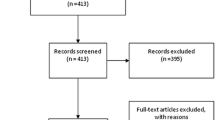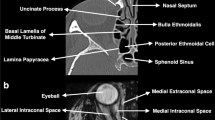Abstract
Background
Various approaches have been described and used for operating on lesions in the orbit. The approach selection is based on the pathology in the orbit and its exact location. This study was performed to evaluate the endoscopic endonasal approach (EEA) for orbital lesions and application of intraoperative MRI (iMRI).
Methods
Since 2006, the present authors have performed 614 endoscopic endonasal procedures. iMRI was used in 409 of these cases. Three orbital lesions approached via the endonasal route with a minimum follow-up of 1 year were analysed.
Results
EEA was used in one case of intraconal cavernoma, one extraconal cavernoma and one solitary fibrous tumour in the orbit. The lesion was located medially to the optic nerve in all cases. Radical resection was achieved and the patient's vision was improved in two cases with a preoperative visual field deficit. iMRI was useful in two cases. In one case intraoperative MRI helped to find an intraconal lesion; in the other case iMRI led to evacuation of haemostatic material and blood, which was causing compression in the orbit.
Conclusions
The EEA should be considered whenever a lesion in the orbit is located medially to the optic nerve. Excellent results were achieved. iMRI proved useful in selected cases.






Similar content being viewed by others
References
Adeolu AA, Sutherland GR (2006) Intraoperative magnetic resonance imaging and meningioma surgery. West Afr J Med 25(3):174–178
Brusati R, Goisis M, Biglioli F, Guareschi M, Nucci P, Gianni AB, Miglior S (2007) Surgical approaches to cavernous haemangiomas of the orbit. Br J Oral Maxillofac Surg 45(6):457–62
Campbell PG, Yadla S, Rosen M, Bilyk JR, Murchison AP, Evans JJ (2011) Endoscopic transnasal cryo-assisted removal of an orbital cavernous hemangioma: a technical note. Minim Invasive Neurosurg 54(1):41–43
Cerdá-Nicolás M, Löpez-Gines C, Gil-Benso R, Benito R, Pellin A, Ruiz-Saurí A, Sanchos-Garcia J, Roldan P, Talamantes F, Barberá J (2006) Solitary fibrous tumor of the orbit: morphological, cytogenetic and molecular features. Neuropathology 26(6):557–563
Gazioglu N, Abuzayed B, Tanriover N (2011) Neuronavigation-guided endoscopic endonasal excision of an intraorbital intraconal cavernous hemangioma. J Craniofac Surg 22(5):1802–1805
Günalp I, Gündüz K (1995) Vascular tumors of the orbit. Doc Ophthalmol 89(4):337–45
Hassler WE, Meyer B, Rohde V, Unsöld R (1994) Pterional approach to the contralateral orbit. Neurosurgery 34(3):552–554
Hayashi S, Kurihara H, Hirato J, Sasaki T (2001) Solitary fibrous tumor of the orbit with extraorbital extension: case report. Neurosurgery 49(5):1241–5
Herman P, Lot G, Silhouette B, Marianowski R, Portier F, Wassef M, Huy PT (1999) Transnasal endoscopic removal of an orbital cavernoma. Ann Otol Rhinol Laryngol 108(2):147–50
Karaki M, Kobayashi R, Mori N (2006) Removal of an orbital apex hemangioma using an endoscopic transethmoidal approach: technical note. Neurosurgery 59(1 Suppl 1):ONSE159–60
Kelly JJ, Hader WJ, Myles ST, Sutherland GR (2005) Epilepsy surgery with intraoperative MRI at 1.5 T. Neurosurg Clin N Am 16(1):173–183
Krause E, Gürkov R, Klauss V (2009) Solitary fibrous tumor in the orbit. Case report and review of the literature. HNO 57(2):169–172
Krishnakumar S, Subramanian N, Mohan ER, Mahesh L, Biswas J, Rao NA (2003) Solitary fibrous tumor of the orbit: a clinicopathologic study of six cases with review of the literature. Surv Ophthalmol 48(5):544–554
Lee JY, Ramakrishnan VR, Chiu AG, Palmer J, Gausas RE (2012) Endoscopic endonasal surgical resection of tumors of the medial orbital apex and wall. Clin Neurol Neurosurg 114(1):93–98
Locatelli M, Carrabba G, Guastella C, Gaini SM, Spagnoli D (2011) Endoscopic endonasal removal of a cavernous hemangioma of the orbital apex. Surg Neurol Int 2:58
Mastronardi L, Elsawaf A, Roperto R, Bozzao A, Caroli M, Ferrante M, Ferrante L (2007) Prognostic relevance of the postoperative evolution of intramedullary spinal cord changes in signal intensity on magnetic resonance imaging after anterior decompression for cervical spondylotic myelopathy. J Neurosurg Spine 7(6):615–622
Meyer D, Riley F (2006) Solitary fibrous tumor of the orbit: a clinicopathologic entity that warrants both a heightened awareness and an atraumatic surgical removal technique. Orbit 25(1):45–50
Miller NR, Agrawal N, Sciubba JJ, Lane AP (2008) Image-guided transnasal endoscopic resection of an orbital solitary fibrous tumor. Ophthal Plast Reconstr Surg 24(1):65–67
Mir-Salim PA, Berghaus A (1999) Endonasal, microsurgical approach to the retrobulbar region exemplified by intraconal hemangioma. HNO 47(3):192–195
Murchison AP, Rosen MR, Evans JJ, Bilyk JR (2011) Endoscopic approach to the orbital apex and periorbital skull base. Laryngoscope 121(3):463–467
Netuka D, Ostrý S, Belšán T, Kramář F, Beneš V (2011) Intraoperative MR imaging in a case of a cervical spinal cord lesion. J Neurosurg Spine 14(6):754–757
Nimsky C, Ganslandt O, Von Keller B, Romstock J, Fahlbusch R (2004) Intraoperative high-field-strength MR imaging: implementation and experience in 200 patients. Radiology 233(1):67–78
Nimsky C, von Keller B, Ganslandt O, Fahlbusch R (2006) Intraoperative high-field magnetic resonance imaging in transsphenoidal surgery of hormonally inactive pituitary macroadenomas. Neurosurgery 59(1):105–114
Schick U, Dott U, Hassler W (2003) Surgical treatment of orbital cavernomas. Surg Neurol 60(3):234–44
Schwartz TH, Marks D, Pak J, Hill J, Mandelbaum DE, Holodny AI, Schulder M (2002) Standardization of amygdalohippocampectomy with intraoperative magnetic resonance imaging: preliminary experience. Epilepsia 43(4):430–436
Sethi DS, Lau DP (1997) Endoscopic management of orbital apex lesions. Am J Rhinol 11(6):449–455
Shields JA, Shields CL, Scartozzi R (2004) Survey of 1264 patients with orbital tumors and simulating lesions: The 2002 Montgomery Lecture, part 1. Ophthalmology 111(5):997–1008
Tomazic PV, Stammberger H, Habermann W, Gerstenberger C, Braun H, Gellner V, Mokry M, Klein A, Langmann G, Köele W (2011) Intraoperative medialization of medial rectus muscle as a new endoscopic technique for approaching intraconal lesions. Am J Rhinol Allergy 25:363–367
Toniato G, Skrap M (2009) Orbital lesions: surgical management within a multidisciplinary treatment. Neurosurg Sci 53(3):77–91
Vitaz TW, Hushek SG, Shields CB, Moriarty TM (2002) Interventional MRI-guided frameless stereotaxy in pediatric patients. Stereotact Funct Neurosurg 79(3–4):182–190
Vitaz TW, Hushek S, Shields CB, Moriarty T (2001) Changes in cyst volume following intraoperative MRI-guided Ommaya reservoir placement for cystic craniopharyngioma. Pediatr Neurosurg 35(5):230–234
Walker JB, Harkey HL, Buciuc R (2008) Percutaneous placement of an external drain of the cisterna magna using interventional magnetic resonance imaging in a patient with a persistent cerebrospinal fluid fistula: technical case report. Neurosurgery 63(2):E375
Yoshimura K, Kubo S, Yoneda H, Hasegawa H, Tominaga S, Yoshimine T (2010) Removal of a cavernous hemangioma in the orbital apex via the endoscopic transnasal approach: a case report. Minim Invasive Neurosurg 53(2):77–79
Acknowledgement
We wish to thank Lenka Bernardová for technical support.
Conflicts of interest
None
Author information
Authors and Affiliations
Corresponding author
Additional information
Supported by grant IGA MZ NT 13631.
Rights and permissions
About this article
Cite this article
Netuka, D., Masopust, V., Belšán, T. et al. Endoscopic endonasal resection of medial orbital lesions with intraoperative MRI. Acta Neurochir 155, 455–461 (2013). https://doi.org/10.1007/s00701-012-1585-9
Received:
Accepted:
Published:
Issue Date:
DOI: https://doi.org/10.1007/s00701-012-1585-9




